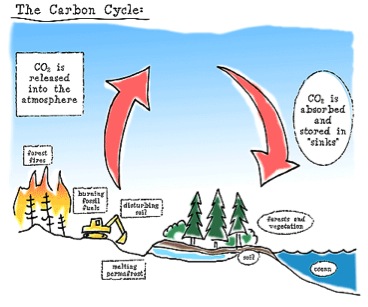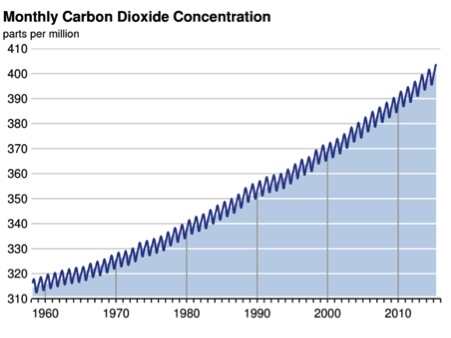
Part II of a three-part sustainability series by guest blogger Larry Eighmy, managing principal of The Stone House Group
You may recall learning about the carbon cycle in your school days, but did you know that understanding this cycle is imperative to understanding climate change and sustainability?
You can think of carbon dioxide as the common currency used to determine our impact on the environment. The gas is an important factor to achieving long-term sustainability that we all need to consider.
Here are the three things you need to know about carbon dioxide and climate change:
1. Carbon is concrete and can be measured. Carbon dioxide (CO2) is naturally present in the earth’s atmosphere and is essential for the existence of life on Earth. CO2 is constantly being transferred between animals, plants, the ocean, the atmosphere, and the soil in a naturally occurring and self-sustaining cycle. CO2 and other greenhouse gases (GHGs) in Earth’s atmosphere produce the greenhouse effect, where these gases protect Earth from dangerous solar radiation and keep the planet at a habitable temperature. All gases, including water vapor, can impact the cycle and are all measured in terms of CO2 equivalents (CO2 e’s). The Kyoto Protocol, an international agreement that committed 192 parties to reducing man-made greenhouse-gas emissions, defined the most significant greenhouse gases and their associated global warming potential, which paved the way for benchmarking and tracking carbon impact.
2. Carbon levels are rising. Concentrations of CO2 and greenhouse gases in the atmosphere are now being amplified by the fossil fuels and petrochemicals we use every day in our industrialized society. Proof of this amplification can be seen in the Keeling Curve (shown below). The curve reflects the work of Charles David Keeling, PhD, a professor at Scripps Institution of Oceanography, who, starting in 1958, took monthly measurements of the CO2 concentrations at Mauna Loa Observatory in Hawaii. Keeling’s work, along with ice core data that tracked CO2 concentrations from as far back as 800,000 years ago, shows that CO2 levels are rising at a dramatic rate and are approaching concentrations that have not been seen on Earth for millions of years.
3. Monitoring and reducing carbon usage saves money, in addition to making us better global citizens. As individuals, we can track our carbon footprint (much as we track our activity level with fitness trackers) through our energy and water bills, our gas bills for cars and lawn mowers, and the pesticides we use on our plants. Free online tools exist to help estimate your carbon footprint, such as The Earth Day Network Footprint Calculator. Companies are also starting to track CO2 associated with their enterprises. In many ways, these actions measure embodied energy—the sum of energy required for the mining, manufacture, and transport of materials to a building site. Some of these actions have been codified. For instance, as part of its LEED building certification program, the U.S. Green Building Council provides a credit for builders utilizing material that is sustainably grown, is recycled, or is local.
Similarly, there is a concept popularized by sustainably minded architect William McDonough called Cradle-to-Cradle that says we must account for the energy used in the entire life cycle of a product. Because of pressure from their customers and shareholders, corporations and institutions create Climate Pledges to commit to reducing their carbon footprints, or Climate Action Plans to focus on strategic management and cost-effective reductions of CO2 emissions. These are all proxies for lower embodied energy
As the famous quote usually attributed to management consultant Peter Drucker states, “What can be measured can be managed.” It follows that by measuring, we can manage our CO2 emissions. The process begins with the seemingly small step of reviewing the carbon cycle we learned in 6th-grade Earth Science.
Once they understand the cycle, individuals and corporations alike can understand their contribution to it and start to make changes to reduce their footprint. Small changes will become bigger, and eventually our society can go from walking to running toward sustainability.
As William McDonough likes to say, “Sustainability takes forever, and that is the point.” It will be a continuous habit, encouraged by measurement, which will soon become second nature to the human race. By understanding our carbon impact we will make more informed decisions and eventually prove to Kermit the Frog that it IS easy being green!
 Larry Eighmy is the managing principal of The Stone House Group, which helps clients find the overlap between financial and environmental sustainability through energy management, climate action plans, facilities management, and sustainable design services. The company has served more than 250 clients, from Pennsylvania’s Lehigh Valley to the Caribbean and the Far East. The company practices what it advocates, as evidenced by its development of a Zero Carbon Neighborhood at the Flat Iron in South Bethlehem, Pennsylvania, where the company is headquartered.
Larry Eighmy is the managing principal of The Stone House Group, which helps clients find the overlap between financial and environmental sustainability through energy management, climate action plans, facilities management, and sustainable design services. The company has served more than 250 clients, from Pennsylvania’s Lehigh Valley to the Caribbean and the Far East. The company practices what it advocates, as evidenced by its development of a Zero Carbon Neighborhood at the Flat Iron in South Bethlehem, Pennsylvania, where the company is headquartered.






No comments yet.